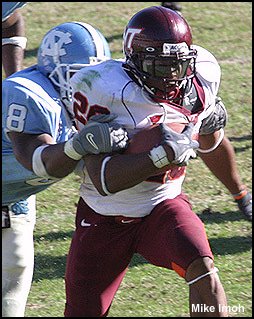 Late
in the third quarter, Tech guard Jason Murphy pulled around the right side,
drove UNC safety Gerald Sensabaugh back five yards and then pancaked him into
the Kenan Stadium turf. Mike Imoh followed Murphyís big block into the end
zone for his second touchdown of the game, giving the Hokies a comfortable (or
so it seemed) 13-point lead.
Late
in the third quarter, Tech guard Jason Murphy pulled around the right side,
drove UNC safety Gerald Sensabaugh back five yards and then pancaked him into
the Kenan Stadium turf. Mike Imoh followed Murphyís big block into the end
zone for his second touchdown of the game, giving the Hokies a comfortable (or
so it seemed) 13-point lead.
The game was playing out just like the Hokies had planned
Ė they were dominating the line of scrimmage, they were running the ball with
ease, they were controlling the clock and they were keeping UNCís offense on
the sideline. Suddenly, everything changed when UNC got three big plays against,
of all things, Techís special teams. Over the next five minutes, UNC would
have its longest kickoff and punt returns of the season, then top those off with
a blocked punt for a touchdown.
Once in control, the Hokies found themselves in another
fourth quarter nail biter that came down to the last play of the game.
Fortunately, thanks to a huge sack by Jim Davis, the Hokies were able to pull
out another big road win and qualify for their 12th consecutive bowl game.
Tech Defense vs. UNC Offense
The UNC offense was expected to be good and they delivered
early, hitting for big play touchdowns in both the run game and the pass game.
But the Tech defense stayed tough, made a few key adjustments, and held the Tar
Heels offense to three points for the rest of the game. There are a few areas to
tighten up, but all in all, it was another strong effort by Bud Fosterís unit.
Key #1: Gap Control vs. the Run
Techís defense started the game with wide splits along
the defensive line, press man outside, with two-deep safeties. The plan was to
show a lot of 2-deep stuff and before the snap, rotate into an 8-man front with
man coverages in the secondary.
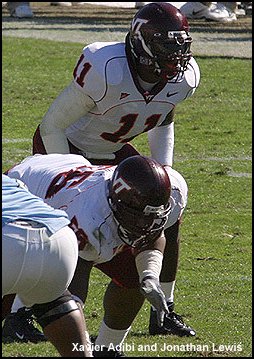 UNC
had little difficulty adjusting to the defensive sets, moving the ball
effectively with the run game early. UNCís offensive line got a good push at
the line of scrimmage and the combination of Darian Durantís mobility and Chad
Scottís quickness created problems for Techís linebackers. James Anderson
struggled on the initial drive, getting taken out by UNCís linemen and tight
ends on successful run plays.
UNC
had little difficulty adjusting to the defensive sets, moving the ball
effectively with the run game early. UNCís offensive line got a good push at
the line of scrimmage and the combination of Darian Durantís mobility and Chad
Scottís quickness created problems for Techís linebackers. James Anderson
struggled on the initial drive, getting taken out by UNCís linemen and tight
ends on successful run plays.
The long touchdown run by Scott came against a Tech blitz
with man coverage outside. Techís defense was in relatively good position on
the play, but both safeties missed tackles and with the corners in man coverage,
it was clear sailing for Scott to the end zone.
For the remainder of the game, the Tech defense played
fairly well against the run. Scott had a play pop for good yardage here and
there, but UNC had difficulty sustaining consistent success with the run.
Considering UNCís offensive line is the strength of their offense, I thought
Techís defensive line battled them to a draw. Jason Brown, UNCís outstanding
center who personally dismantled the interior of Miamiís defensive line last
week, found the interior of Techís defense more difficult to handle.
Looking ahead a couple of weeks to Marques Hagans and UVa,
mobile quarterbacks remain a concern for the Tech defense. Darian Durant was
difficult to contain, whether he was running bootlegs or scrambling out of the
pocket. As expected, Tech initially played containment on the boundary with a
defensive end and Durant was able to break it on a couple of plays. UNC also
tried to get Durant to the edge when they saw Vince Hall accounting for him to
the boundary. Techís adjustment to more zone coverages not only took away some
things UNC tried to do in the passing game, but it also proved to be a little
more effective in checking Durantís run options.
Key #2: Pressure Durant; Force Him Left
The Hokies put good pressure on Durant throughout the
game, but they had difficulty actually catching him and getting him on the
ground (with the one big exception there at the end of the game). The Tech
linebackers blitzed on several occasions, but Durant was able to escape sacks
and other lost yardage plays.
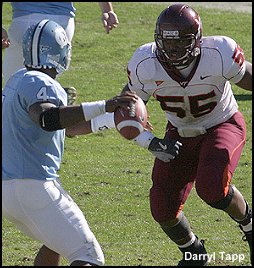 Going
into the game, I was most concerned about Durantís ability to get big plays
when throwing on the run, especially to his right. That was certainly part of
the UNC offensive game plan and Durant did hit some midrange pass plays while on
the move. The Tech defense countered with a lot of zone looks, including zone
pressures. UNC hit the big pass plays against man and man free coverages, but
only had moderate success against Techís zone coverages. That forced UNC to
sustain drives, something which they were unable to do in this game.
Going
into the game, I was most concerned about Durantís ability to get big plays
when throwing on the run, especially to his right. That was certainly part of
the UNC offensive game plan and Durant did hit some midrange pass plays while on
the move. The Tech defense countered with a lot of zone looks, including zone
pressures. UNC hit the big pass plays against man and man free coverages, but
only had moderate success against Techís zone coverages. That forced UNC to
sustain drives, something which they were unable to do in this game.
One note that has little to do with this key, but is worth
mentioning here. Everyone knows that Techís defense is much improved compared
to the last couple of years. But no single area has improved more than the
execution of zone defenses. Techís successful defenses of the past were known
for an attacking style, with endless pressure and aggressive man-to-man
coverages. Zones were considered a secondary necessity and they were noticeably
awkward and stiff in execution. That is no longer the case. Tech is now much
more multiple, playing a full suite of zone defenses with success. A big part of
that is the players staying disciplined and playing their assignments within the
system. Zones fail miserably when players are not on the same page. The fact
that Techís zone defenses are so effective this year is just one data point
that validates that the players are in synch with each other and playing
together as a team.
Key #3: Defend the Tendencies
UNC had early success running to the right, away from
their primary tendency. After the initial touchdown drive, UNC had moderate
success running the ball, but they were unable to sustain productive drives with
their run game.
UNC likes to pull their guards and center, but Techís
wide splits along the defensive line created matchup problems along the line of
scrimmage. Penetration inside, particularly by Jonathan Lewis, took away some of
the cutback opportunities. The Tech linebackers didnít have spectacular games,
but they more than held their own against a formidable attack. Considering he
was questionable going into the game, I thought Vince Hall played particularly
well. He could have easily been on the other sideline on Saturday, coming within
a whisker of committing to UNC two years ago. He was good at the point of attack
and even better in pursuit.
On their last drive of the game, UNC really played to
their tendencies. They went left on successive running plays, first with Durant
on a bootleg and then Chad Scott off fullback misdirection. Durant followed by
throwing outside to his right and then hitting Jawarski Pollock on a big play
down the middle in a soft spot between zones.
With UNC in field goal range, Techís defense made two
big plays back to back that made the difference in the end. On 2nd down, UNC got
what they wanted Ė isolation of Chad Scott against Mike Daniels in man
coverage. The swing pass had twice gone for good yardage earlier in the game,
but on this play, Daniels read it right away, got an excellent jump and chased
down Scott for a two yard loss. The Jim Davis sack followed on 3rd down,
effectively pushing UNC out of field goal range.
Key #4: Disguise and Mix Coverages
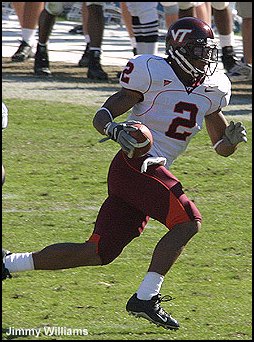 This
one boils down rather simply. Tech mixed defenses, but had much more success
with zones than with man coverages in this game. Being an experienced senior QB,
Durant didnít have too many problems reading the Tech defense, although his
lone interception came against a blown coverage in the secondary. Jimmy Williams
read Durant perfectly on that play and got the easy pick, even though he was out
there as a single defender against two receivers.
This
one boils down rather simply. Tech mixed defenses, but had much more success
with zones than with man coverages in this game. Being an experienced senior QB,
Durant didnít have too many problems reading the Tech defense, although his
lone interception came against a blown coverage in the secondary. Jimmy Williams
read Durant perfectly on that play and got the easy pick, even though he was out
there as a single defender against two receivers.
UNC came into the game planning to attack the Hokies man
coverage at every opportunity. They felt that they had some mismatches against
the Tech secondary in man-to-man coverage. They looked to get receivers isolated
with motion and a variety of formations. They had success getting the ball to
Chad Scott on the edge, isolated against a linebacker or safety. They used
motion to get Jawarski Pollock isolated underneath the corners and, when the
opportunity was there, they went up top between the hashes against the Tech
safeties in man coverage. Vinnie Fullerís injury opened up additional mismatch
opportunities, which UNC exploited on their second touchdown. They correctly
read blitz and Cover-0 (man-to-man with no help deep), emptied the backfield and
got WR Wallace Wright isolated inside against Mike Daniels. Daniels is a good,
physical player that rarely makes mistakes, but his speed can be exploited down
the field. Wright ran by him and Durant made a perfect pass for the touchdown.
After that second TD, Bud Foster made the adjustment to
get away from man coverages and play more zone. That took away the big play
opportunities UNC was looking for in the passing game, but they kept looking and
hoping. UNCís last big play in the passing game came in the fourth quarter
when Mike Mason beat Roland Minor down the sideline. Tech was in ďman freeĒ
(Cover-1) on that play, matched up in man-to-man against the UNC receivers, with
a single safety back (Daniels) to provide deep help inside. The corners outside
arenít expecting help and the Heels went to Mason one-on-one against Minor.
Daniels came over, but wasnít a factor in the success of the play for UNC.
Key #5: Play Physical against the Receivers
Techís corners were very physical, but the UNC receivers
get credit for being just as physical. That was a good battle throughout the
afternoon, particularly in the run game. Although he missed a tackle early,
Jimmy Williams was particularly tough in run support.
In the pass game, UNC mostly attacked the middle of the
field against Techís linebackers and safeties. They hit some short stuff
outside on the corners, but didnít take many shots down the field against
either Eric Green or Jimmy Williams. Tech also played a lot of zone which
minimized the physical play of the corners at the line of scrimmage.
Tech Offense vs. UNC Defense
Techís plan on offense was to let Bryan Randall manage
the game. He had run/pass options on every play and would check into one or the
other based on his read of the UNC defense. Randall admitted after the game that
he had a lot of success reading what the defense was doing and then checking
into the right play.
The run game was dominant, but the passing game took a
small step back from the success against Georgia Tech. The offense is still
looking for more consistency in that area. Bryan Randall made some very strong
throws against pressure and tough coverage, but he also missed on a few of the
shorter throws. The receivers made some tough plays, but also dropped some easy
passes. Overall, the offense did some things well, but their 370 total yards was
a season best for the UNC defense.
Key #1: Win the Line of Scrimmage
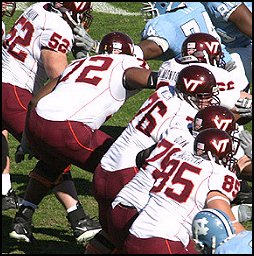 Check!
The Tech offensive line was dominating, particularly Jason Murphy and Jon Dunn.
Murphy showed that he can be a force pulling into the hole and Dunn was strong
at the point of attack. The rest of the line played well, but those two stood
out in my mind. The tight ends also came up big in the run game, improving
significantly over their performance against Georgia Tech.
Check!
The Tech offensive line was dominating, particularly Jason Murphy and Jon Dunn.
Murphy showed that he can be a force pulling into the hole and Dunn was strong
at the point of attack. The rest of the line played well, but those two stood
out in my mind. The tight ends also came up big in the run game, improving
significantly over their performance against Georgia Tech.
As expected, the Hokies used the fullback more in this
game. John Kinzer was hurt and didnít play much, but Jesse Allen was up to the
challenge. He played his biggest role of the season and he made the most of it.
Tech had great success running Mike Imoh from the I-formation, both on fullback
isolations, as well as fullback misdirection. From single back (2-TE)
formations, Tech was successful on stretch runs, pulling center Will Montgomery
into the hole.
Overall, the line got into a rhythm and dominated a porous
UNC defensive front, particularly in the third quarter. Playing on the road,
there were no false starts or illegal formation penalties (at least none that I
remember). That is a sign of a unit that was mentally focused and in synch
throughout the game.
Key #2: Rush for More Yards than UNC
Check! Chad Scott had a good game running the ball against
the Tech defense, but Mike Imoh broke the Tech record for rushing yards in a
game. Imoh ran tough, breaking tackles and getting a significant amount of those
yards after first contact. Imohís emergence as a durable, reliable tailback
that is effective between the tackles, as well as outside on the perimeter, is
significant for the Tech offense. The combination of Imoh and Randall forces
defenses to give more consideration to run containment, which opens up some
opportunities for the receivers down the field.
The success of the Tech running game was one of the main
reasons that the UNC offense was held to under 300 total yards. Techís offense
controlled the clock and dominated time of possession by nearly 13 minutes. That
was the game plan going in and the Tech offense executed that plan flawlessly
for the first three quarters of the game.
Key #3: Run Randall Early
In looking at prior UNC game film, it was evident that
Tech was going to have some opportunities with the option game. They went to it
early, getting Randall on the edge. They followed with an option pitch to Imoh
to the short side from an unbalanced formation. That play came straight out of
film review, yielding a formation that resulted in four Tech blockers against
three UNC defenders on the boundary. That play might have worked later in the
game had Tech found itself in the right situation to try it again.
Tech was just as successful running the option to the wide
side by getting the same advantage in numbers through formation. Defending the
option is strictly about numbers and assignments and UNC did a poor job with
both. Randall made good decisions on keeping versus pitching. UNC adjusted the
alignment of their linebackers, which opened up some inside running lanes for
Mike Imoh.
Key #4: Exploit the Safeties
Gerald Sensabaugh is a good football player with more
speed than I realized. He created some mismatch problems for the Hokies and was
particularly effective on the blitz. Protection problems reared its ugly head a
few times in this game, with Mike Imoh and Jeff King missing their blocks on
Sensabaughís two sacks.
Tech had some chances to get something big against the UNC
safeties, but a drop here, a bad route there, or a misfired pass limited those
opportunities. Josh Hyman had a tough day working the middle of the field
against the UNC safeties. He was a good matchup for Tech against the UNC
safeties and it was clear that he was big part of the game plan. Unfortunately
for Hyman, he dropped some passes that could have been big plays for the
offense.
Fullback and 2-TE formations forced UNC to bring one or
both safeties closer to the line of scrimmage for run support. Tech took
advantage by getting push against the defensive front and then releasing
blockers into the safeties on the second level. The safeties got run over on
more than a few plays. UNCís defensive line got up off the turf and held their
ground much better in the 4th quarter. They looked exhausted after the long Tech
drive that resulted in Mike Imohís second touchdown, but they got their second
wind shortly thereafter. Of course, the eight minutes of TV timeouts that ran
almost back to back at the end of the 3rd quarter / start of the 4th quarter
greatly helped their cause.
Key #5: Attack the Corners
The story here was Eddie Royal. The passing game had its
struggles throughout the game, but when they hit, it was usually Randall to
Royal. They are developing a good rhythm with each other, with Royal becoming
Randallís go-to guy. Royal still has some work to do with his run blocking,
but his receiving skills continue to impress.
In the 2nd quarter, Randall made one the better passes of
his career, hitting Royal on an out to the wide side of the field with pressure
in his face. That pass traveled about 25-30 yards in the air. It was thrown on
time, to a spot, with good zip. Later, on a 1st and 25 after a chop block
penalty, Randall hit Royal again on an out pass that traveled about 30 yards in
the air. Royal broke the route precisely and came back to the ball to shield off
the corner.
Those two passes came in big situations where Tech felt
they had a matchup advantage with Royal against the UNC corners. There was
another sequence on Techís second drive of the game that reflected the plan to
attack the coverage. On first down, Randall misread ďman freeĒ as a zone
coverage and threw an incomplete pass to Josh Hyman that was well defended in
the middle of the field. On the next play, Randall read ďman freeĒ correctly
and lofted a pass to Eddie Royal streaking down the sideline one on one against
the corner. Royal made another great play on the ball for big yardage. The
single safety, aligned to help in the deep middle, couldnít get over in time
to give help to the corner on the sideline.
Conclusions
This was a game where everyone on the team feels good
about the victory, but they know that there were some not-so-good things that
need attention in preparation for Maryland. The defense played another
consistent game, but they can ill afford to lose Vinnie Fuller, the quarterback
of the defense on the field. The offense dominated the trenches and set an
individual record rushing the football, but the operation still needs more
consistency, particularly in the passing game. Then there are the special teams,
which need a big rebound from a poor performance against UNC.
The Hokies now get a short break while waiting to host the
Terps a week from Thursday. Iíll take that break right along with them, coming
back early next week with the keys to the game.